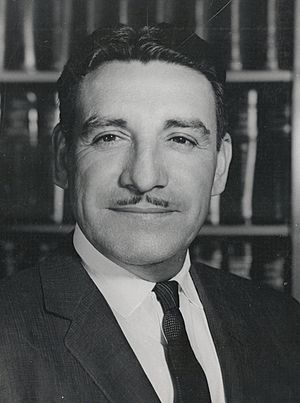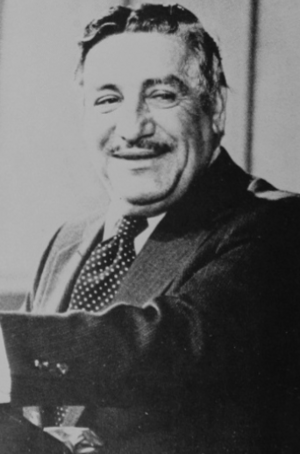Raúl Héctor Castro facts for kids
Quick facts for kids
Raúl Héctor Castro
|
|
|---|---|
 |
|
| United States Ambassador to Argentina | |
| In office November 16, 1977 – July 30, 1980 |
|
| President | Jimmy Carter |
| Preceded by | Robert Hill |
| Succeeded by | Harry Shlaudeman |
| 14th Governor of Arizona | |
| In office January 6, 1975 – October 20, 1977 |
|
| Preceded by | Jack Williams |
| Succeeded by | Wesley Bolin |
| United States Ambassador to Bolivia | |
| In office September 3, 1968 – November 3, 1969 |
|
| President | Lyndon B. Johnson Richard Nixon |
| Preceded by | Douglas Henderson |
| Succeeded by | Ernest Siracusa |
| United States Ambassador to El Salvador | |
| In office December 11, 1964 – July 17, 1968 |
|
| President | Lyndon B. Johnson |
| Preceded by | Murat Williams |
| Succeeded by | William Bowdler |
| Personal details | |
| Born |
Raúl Castro
June 12, 1916 Cananea, Sonora, Mexico |
| Died | April 10, 2015 (aged 98) San Diego, California, U.S. |
| Political party | Democratic |
| Spouse |
Patricia Steiner
(m. 1959) |
| Education | Northern Arizona University (BS) University of Arizona (JD) |
Raúl Héctor Castro (June 12, 1916 – April 10, 2015) was an important Mexican American leader. He was a politician, a diplomat, and a judge. Castro served as the United States Ambassador to El Salvador and later as the United States Ambassador to Bolivia. In 1974, he became the 14th governor of Arizona. He then resigned to become the United States Ambassador to Argentina. Before his public service, Castro worked as a lawyer and a judge in Pima County, Arizona. He was a member of the Democratic Party.
Raúl Castro was born in Cananea, Sonora, Mexico. In 1926, his family moved to Arizona, near Douglas. He went to Arizona State Teachers College, now called Northern Arizona University. After college, he worked for the U.S. Department of State in Mexico. He later returned to Arizona to study law at the University of Arizona College of Law. Castro became a deputy county attorney for Pima County. He was elected county attorney in 1954. In 1958, he became a Pima County Superior Court Judge.
In 1964, President Lyndon B. Johnson chose Castro to be the U.S. Ambassador to El Salvador. He served there for four years. Then, he was appointed U.S. Ambassador to Bolivia. He left this role in 1969 to start a political career in Arizona. Castro ran for governor of Arizona in 1970 but lost. He ran again in 1974 and won. Two years into his term, President Jimmy Carter asked him to be the U.S. Ambassador to Argentina. Castro accepted and resigned as governor. He finished his public service career in 1980. Raúl Héctor Castro passed away at age 98 in San Diego, California.
Contents
Early Life and Education
Raúl Castro was born in Cananea, Sonora, Mexico, on June 12, 1916. He was one of fourteen children. His father, Francisco Dominguez Castro, was a miner. His mother, Rosario Acosta, taught his father to read and write. In 1926, his family moved to Pirtleville, Arizona, near Douglas. They became U.S. citizens. Castro's father read Mexican newspapers to him, which sparked his interest in politics.
When Castro was a teenager, his father died. His mother became a midwife to support the family. Castro went to the Fifteenth Street School in Douglas, which was only for Mexican students. Spanish was not allowed, so he had to learn English quickly. In high school, Castro played football as a quarterback and competed in track and field. He adopted the middle name Héctor because he admired a basketball player with that name. His high school principal told him not to go to college, saying it would be a waste of time.
Despite this, Castro earned a football scholarship to Arizona State Teachers College in Flagstaff. This school is now Northern Arizona University. He worked washing dishes and later as an assistant cook to pay for school. He also boxed and taught a sixth-grade class. At 23, Castro became a U.S. citizen. He tried to get a teaching job in Douglas but was turned down because he was Mexican.
He then worked for the U.S. Department of State as a clerk in Agua Prieta, Mexico. A friend convinced him to become a lawyer instead. He decided to attend the University of Arizona College of Law. To pay for law school, Castro became a Spanish professor at the University of Arizona. He earned his law degree in 1949. In 1959, he married Patricia Steiner, and they had two daughters.
Law Career and Ambassador Roles
After law school, Castro practiced law in Tucson. He then became a deputy county attorney for Pima County, Arizona. In 1954, he decided to run for county attorney himself. He won by a small number of votes, becoming the first Mexican American to hold this position in Arizona. He served until 1958, when he became a Pima County Superior Court Judge.
Castro gained a good reputation as a judge. He was offered a position as a United States Attorney, but he wanted to be a U.S. Ambassador instead. Senator Carl Hayden spoke to President Lyndon B. Johnson about Castro. President Johnson was at first worried because Castro's last name was the same as Fidel Castro, the Cuban leader. Johnson asked Castro to change his name, but Castro refused. Johnson eventually agreed, and Castro became the United States Ambassador to El Salvador in 1964. While there, he received the country's highest honor, the Order of José Matías Delgado.
After four years, he was appointed United States Ambassador to Bolivia. He was known as the "Ambassador on Horseback" because he would ride into the countryside to meet Bolivian citizens. His home was bombed twice while he was ambassador. He served until 1969, when Richard Nixon became president, and Castro was removed from office.
Political Career
Running for Governor in 1970
After returning to Arizona, Castro was asked to run for Governor of Arizona in the 1970 Arizona gubernatorial election. He announced his campaign for the Democratic nomination. Many people thought he had no chance. However, Castro won the Democratic nomination by a large margin. He then ran against the current governor, Jack Williams.
During the election, some Republicans criticized Castro. They said he favored Mexican immigrants when he was county attorney. They also said he was an "adequate" judge, not an "outstanding" one. Castro lost the election by a very small margin. Williams won with 50.9% of the vote, and Castro had 49.1%.
Running for Governor in 1974
Governor Jack Williams decided not to run again in 1974. This opened the door for many candidates. Castro decided to run for the Democratic nomination again in the 1974 Arizona gubernatorial election. He faced little opposition and easily won the primary. The Republican primary was very close, and Russell Williams became their nominee.
The Hispanic community was very excited about Castro's chance to become governor. Many people volunteered for his campaign. Castro won the general election by another very close margin. He received only 4,119 more votes than Russell Williams. His victory was helped by strong support from the Navajo voters in Navajo and Apache counties.
A few weeks after the election, Castro attended a bank opening in Mexico. When he returned to the U.S., a border officer asked him for proof of citizenship. Castro, who was the Governor-Elect, suggested they call Senator Goldwater to confirm his identity.
Governor of Arizona (1975–1977)
On January 6, 1975, Castro became the 14th Governor of Arizona. He was the first Mexican American to hold this position since Arizona became a state in 1912. During his time as governor, Republicans often criticized him. They felt he cared more about the title than the duties of the job.
While governor, Castro campaigned for Jimmy Carter in the 1976 presidential election. Carter was a former governor of Georgia. Even though Castro campaigned for him, Gerald Ford won Arizona. Castro also helped Carter's campaign in New Mexico and Texas.
Resignation and U.S. Ambassador to Argentina
Castro faced increasing criticism as Governor of Arizona. In 1977, President Jimmy Carter offered him the position of U.S. Ambassador to Argentina. Wesley Bolin, the Arizona Secretary of State, became governor after Castro resigned. Bolin passed away less than a year later.
Castro felt mixed about resigning. He did not want to disappoint the Hispanic community who helped elect him. However, he later said he believed he could help the Hispanic community more as U.S. Ambassador to Argentina. In Argentina, Castro again faced challenges because of his Mexican heritage. Some Argentinians wondered why the U.S. chose a Mexican person for the role. Castro served as ambassador from 1977 to 1980. This was his last political office.
Honors
In 2007, Northern Arizona University, Castro's old college, named a building after him. This building is home to the College of Social and Behavioral Sciences. Castro competed in track and boxing when he was a student there. He was inducted into the Northern Arizona University Athletics Hall of Fame in 1988. He also joined the College of Social and Behavioral Science Hall of Fame in 2011.
Detainment by Border Patrol
On June 12, 2012, his 96th birthday, Castro was stopped by United States Border Patrol agents. He was a passenger in a car going to a birthday celebration. The agents detected a small amount of radiation from the car. This was likely caused by a medical procedure Castro had the day before. Castro was made to wait outside the car in nearly 100-degree heat without water for half an hour.
Death
On April 10, 2015, Raúl Héctor Castro passed away in his sleep. He was 98 years old and was receiving hospice care in San Diego.
See also
 In Spanish: Raúl Héctor Castro para niños
In Spanish: Raúl Héctor Castro para niños
- List of governors of Arizona
- List of Hispanic/Latino American jurists
- List of minority governors and lieutenant governors in the United States
- List of U.S. state governors born outside the United States


